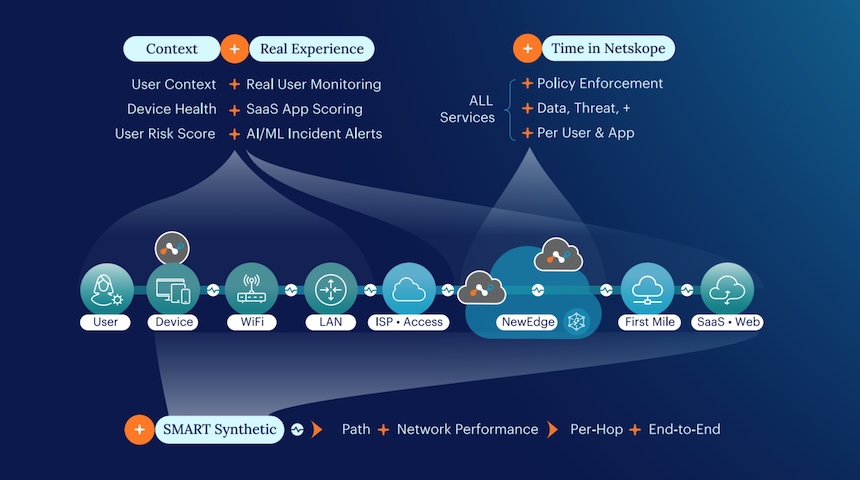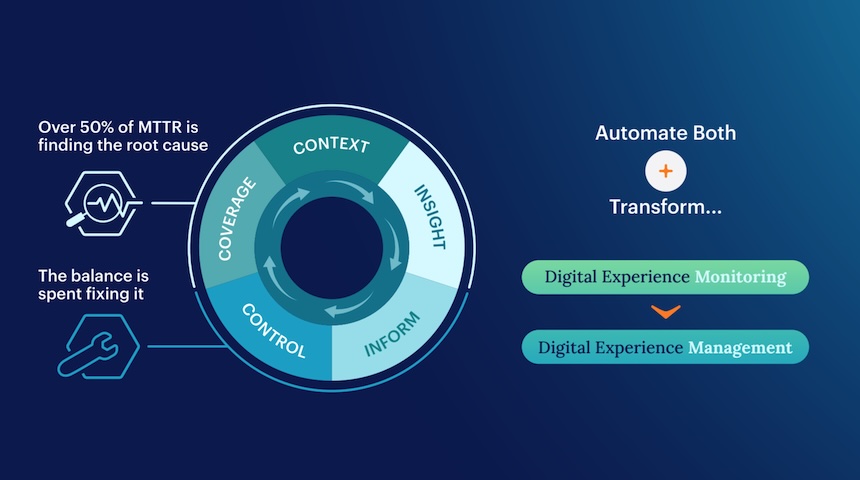Digital transformation and its challenges
In today’s era of digital transformation, organizations are rapidly shifting towards a distributed and dynamic digital infrastructure. This new reality is characterized by hybrid workforces, software as a service (SaaS), and cloud hosting. While this transformation brings numerous benefits, it also introduces significant challenges for IT organizations, particularly in terms of maintaining visibility over user experience and performance management. Traditional IT tools are struggling to keep up, leading to a growing ”visibility gap.”
The visibility gap
The modern workplace, with its highly distributed sites, employees, SaaS applications, and cloud hosting, interconnected by internet-based networks, is dynamic and often unpredictable. This complexity is compounded by the evolving and increasingly fragmented security perimeter, accelerating the implementation of SSE, SD-WAN, and zero trust strategies (SASE). In this context, Infrastructure and Operations (I&O) teams need full visibility across infrastructure, performance, and user experience, which traditional monitoring solutions struggle to provide: APM tools, packet capture, and flow analysis become impractical in the face of strong encryption and the frequent changes in location of users and application hosts.
The rise of digital experience monitoring (DEM)
A new kind of visibility is needed to regain control and accurately monitor dynamic networks, SaaS applications, and the resulting user experience. As a result, digital experience monitoring (DEM) solutions have emerged as a critical tool for IT observability. DEM provides end-to-end visibility that overcomes the limitations of legacy tools, mapping out the full path and infrastructure between endpoints and applications to detect and diagnose bottlenecks.
These solutions track user experience, end-to-end network path, and application performance, offering a comprehensive view that was previously difficult to achieve. To capture a complete view into all layers and locations between users and apps, DEM ideally combines synthetic monitoring and real traffic analysis to accurately measure user experience in context of their location, user activity, environment, network path, security policies and application hosting performance. These insights also highlight opportunities to optimize infrastructure, effectively manage vendors and enforce service level agreements (SLAs) with evidence.

Integrating SASE with DEM for enhanced visibility
DEM’s outside-in approach, while effective for monitoring dynamic and distributed users and applications, faces limitations when it comes to modern zero trust and cloud security environments. When encountering security service edge (SSE) or secure access service edge (SASE) traditional DEM tools can’t see into or through them. As a “gray cloud,” network and security operations teams lack the transparency needed to effectively monitor these environments and isolate any impact they have on user experience.
The integration of SASE with DEM presents a natural and powerful solution to these challenges. SASE-integrated DEM provides a unified view across various domains—network, application, endpoint, and security management. This unique approach not only offers transparency into the influence of security policies and SASE on user experience but also significantly enhances productivity by allowing performance and security to be optimized in context of each other, as measured by the resulting real user experience.
This simplifies collaboration among security, IT, and network teams, resulting in quicker identification and resolution by reducing the “proof of innocence” and finger-pointing that often characterize multi-team troubleshooting.
Proactively Transition from Monitoring to Management
While gaining end-to-end visibility across all connections and domains between devices is essential, optimizing performance and user experience across complex service chains calls for a more comprehensive approach: leveraging monitoring to proactively manage user experience.

Netskope’s Proactive Digital Experience Management (P-DEM) goes beyond visibility to automate remediation across devices, networks, SASE, and applications to continuously optimize user experience and security. This combination of monitoring and proactive management collapses the time to detect and resolve issues by nearly 70%. P-DEM auto-remediation capabilities range from coaching users to fix common Wi-Fi and device issues, traffic management capabilities, dynamic SSE onramp steering, first mile BGP routing optimization, and more.
Netskope achieves this by leveraging its NewEdge private security cloud, that provides a high performance control plane across devices, networks, SSE, and application performance. The combination of P-DEM and NewEdge automates both insight and action, creating a viable context for closed-loop control. In practice, this simplifies IT operations, offloads the help desk, and preemptively mitigates many issues before their impact escalates.
Reaping the benefits of P-DEM
P-DEM offers numerous benefits, including total visibility into user experience, rapid issue resolution, enhanced productivity, and simplified SASE adoption. It’s also fundamental for effectively evaluating, piloting, deploying, and scaling SASE with minimal risk.
P-DEM offers an effective and automated strategy for responsive remediation and continuous improvement. It not only provides comprehensive monitoring but actively manages and optimizes the digital experience, balancing security and performance. By adopting P-DEM, organizations can transform their IT approach, ensuring a more efficient, secure, and productive digital workplace.




 Back
Back 





















 Read the blog
Read the blog